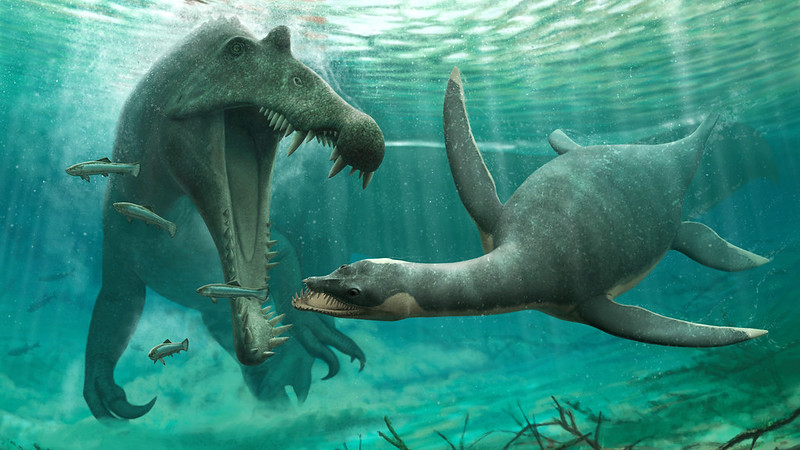今回、古代の川底からプレシオサウルスの化石が発見されたことで、従来は海の生物と考えられていた種が淡水で生活していた可能性が示唆されました。 This discovery of plesiosaur fossils in an ancient riverbed suggests some species, traditionally thought to be sea creatures, may have lived in freshwater.
2022-07-26 バース大学

Plesiosaurus and spinosaurus may have both inhabited freshwater rivers
このたび、英国のバース大学、ポーツマス大学、モロッコのハッサン2世大学の科学者たちが、アフリカの白亜紀の川から小さなプレシオサウルスを発見した。
この化石には、体長3メートルの大人の骨や歯、体長1.5メートルの赤ん坊の腕の骨などが含まれている。これらの化石は、これらの生物が、カエル、ワニ、カメ、魚、そして巨大な水棲恐竜スピノサウルスと並んで、日常的に淡水で生活し、食事をしていたことを示唆している。
これらの化石は、プレシオザウルスが淡水に適応し、現在のカワイルカのように淡水で一生を過ごしていた可能性を示唆している。
<関連情報>
- https://www.bath.ac.uk/announcements/plesiosaur-fossils-found-in-the-sahara-suggest-they-werent-just-marine-animals/
- https://www.sciencedirect.com/science/article/abs/pii/S0195667122001744
モロッコ東部の河川流域ケムケム層群(白亜紀中期)のプレシオサウルスと非海洋プレシオサウルスに関する総説 Plesiosaurs from the fluvial Kem Kem Group (mid-Cretaceous) of eastern Morocco and a review of non-marine plesiosaurs
Georgina Bunker,David M.Martill,Roy Smith,Samir Zourhi,Nick Longrich
Cretaceous Research Available online: 21 July 2022.
DOI:https://doi.org/10.1016/j.cretres.2022.105310
Abstract
Plesiosaurs were a long-lived and widespread group of marine reptiles, with a worldwide distribution and a temporal range from the Late Triassic to the Late Cretaceous. Most occur in marine deposits, but some occur in low-salinity, brackish to freshwater environments. We report plesiosaurs from the freshwater fluvial deposits of the mid-Cretaceous (?Albian-Cenomanian) Kem Kem Group of Morocco. Remains include numerous shed teeth, vertebrae, and a humerus. The humerus represents a young juvenile; vertebrae likely belong to sub-adults. Teeth show heavy wear, similar to teeth of co-occurring spinosaurids. While coeval plesiosaurs from the Bahariya Formation of Egypt are members of Polycotylidae, the Kem Kem fossils show features of Leptocleididae, small-bodied plesiosaurs that were widely distributed in nearshore and non-marine settings in the Early Cretaceous. These fossils are the first freshwater plesiosaurs from Morocco, and are among the youngest representatives of Leptocleididae. The Kem Kem leptocleidids could have been infrequent visitors from the sea, freshwater-tolerant, or even freshwater-adapted, as in modern river dolphins. The abundance of shed teeth in the Kem Kem Group supports the hypothesis that they had some degree of freshwater tolerance. Furthermore, leptocleidids occur almost exclusively in shallow nearshore, brackish, or freshwater environments, suggesting adaptation to shallow, low-salinity environments. Other plesiosaur groups and other Mesozoic marine reptiles, including teleosaurids and mosasaurids, also occur in freshwater settings, suggesting plesiosaurs and other marine reptiles frequently exploited non-marine environments.


